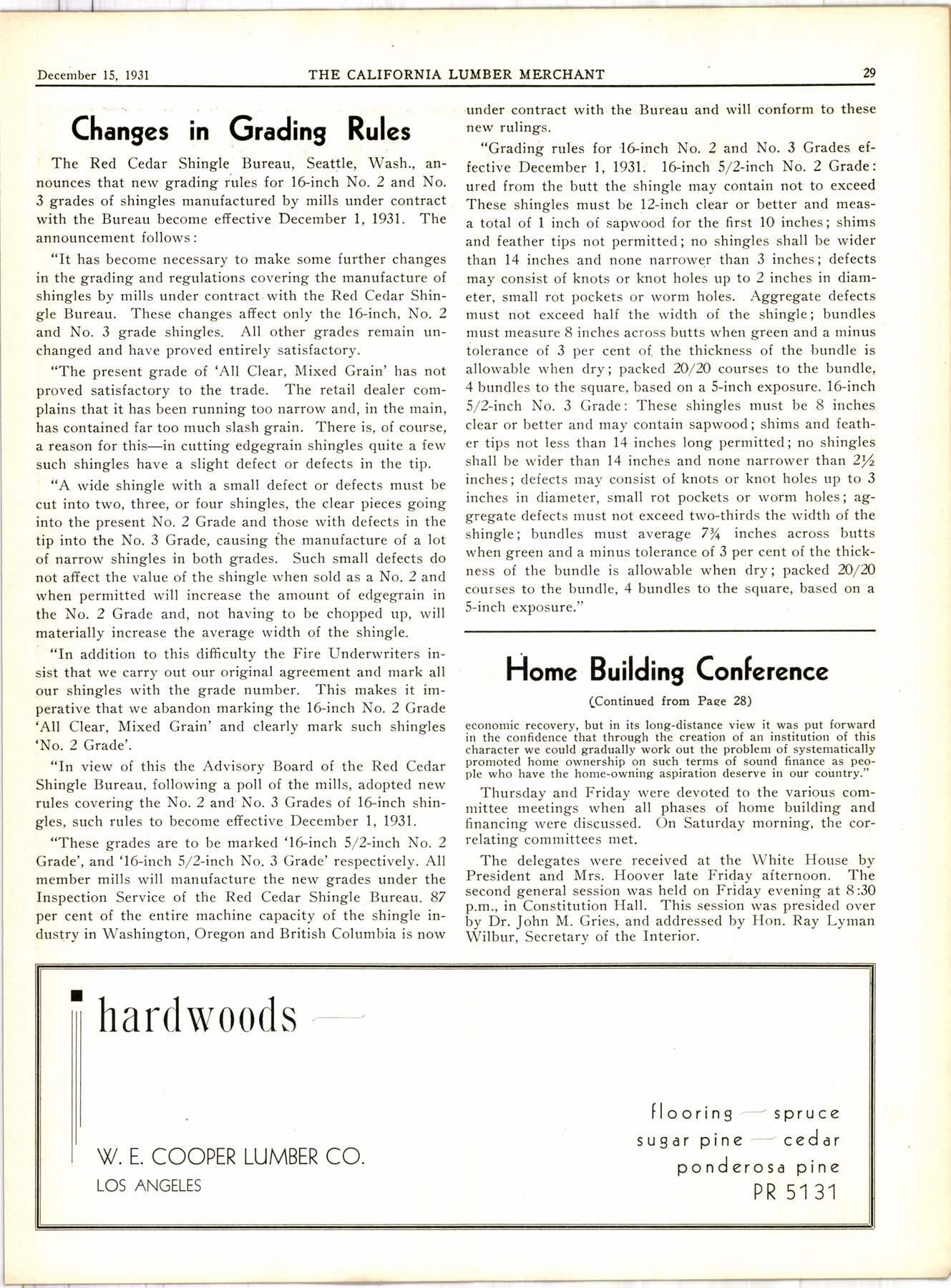
3 minute read
Changes in Grading Rules
The Red Cedar Shingle Bureau, Seattle, 'Wash., announces that new grading rules for l6inch No. 2 and No. 3 grades of shingles manufactured by mills under contract with the Bureau become effective December l. 1931. The announcement follows:
"It has become necessary to make some further changes in the grading and regulations covering the manufacture of shingles by mills under contract with the Red Cedar Shingle Bureau. These changes affect only the 16-inch, No. 2 and No. 3 grade shingles. All other grades remain unchanged and have proved entirely satisfactory.
"The present grade of 'All Clear, Mixed Grain' has not proved satisfactory to the trade. The retail dealer complains that it has been running too narrow and, in the main, has contained far too much slash grain. There is, of course, a reason for this-in cutting edgegrain shingles quite a few such shingles have a slight defect or defects in the tip.
"A wide shingle with a small defect or defects must be cut into two, three, or four shingles, the clear pieces going into the present No. 2 Grade and those with defects in the tip into the No. 3 Grade, causing dhe manufacture of a lot of narrow shingles in both grades. Such small defects do not affect the value of the shingle when sold as a No. 2 and when permitted will increase the amount of edgegrain in the No. 2 Grade and, not having to be chopped up, will materially increase the average width of the shingle. :
"In addition to this difficulty the Fire Underwriters insist that we carry out our original agreement and mark all our shingles with the grade number. This makes it imperative that we abandon marking the 16-inch No. 2 Grade 'All Clear, Mixed Grain' and clearly mark such shingles 'No. 2 Grade'.
"In view of this the Advisory Board of the Red Cedar Shingle Bureau, following a poll of the mills, adopted new rules covering the No. 2 and No. 3 Grades of 16-inch shingles, such rules to become effective December 1, 1931.
"These grades are to be marked '16inch S/2-inch No. 2 Grade', and '16-inch S/Z-inch No. 3 Grade' respectively. All member mills will manu{acture the new grades under the Inspection Service of the Red Cedar Shingle Bureau. 87 per cent of the entire machine capacity of the shingle industry in Washington, Oregon and British Columbia is norv under contract with the Bureau and will conform to these new rulings.
"Grading rules for '16-inch No. ? and No. 3 Grades effective December 1, 1931. lGinch S/Z-inch No. 2 Grade: ured from the butt the shingle may contain not to exceed These shingles must be 12-inch clear or better and measa total of 1 inch of sapwood for the first l0 inches; shims and feather tips not permitted; no shingles shall be wider than 14 inches and none narrower than 3 inches; defects may consist of knots or knot holes up to 2 inches in diameter, small rot pockets or worm holes. Aggregate defects must not exceed half the width of the shingle; bundles must measure 8 inches across butts when gr.een and a minus tolerance of 3 per cent o[ the thickness of the bundle is allowable when dry; packed N/2O courses to the bundle, 4 bundles to the square, based on a S-inch exposure. 16-inch S/2-inch No. 3 Grade: These shingles must be B inches clear or better and may contain sapwood; shims and feather tips not less than 14 inches long permitted; no shingles shall be wider than 14 inches and none narrower than 2l inches; defects may consist of knots or knot holes up to 3 inches in diameter, small rot pockets or worm holes; aggregate defects must not exceed two-thirds the width of the shingle; bundles must average 7% inches across butts when green and a minus tolerance of 3 per cent of the thickness of the bundle is allowable when dry1, packed ZO/N courses to the bundle, 4 bundles to the square, based on a 5-inch exposure."
Home Building Confer ence
(Continued from Paee 28) economic recovery, but in its long-distance view it was put forward ir, the confidence that through the creation of an institution of this character we could gradually work out the problem of systematically promoted home ownership on such terms of sound finance as people who have the home-owning aspiration deserve in our coirntry."
Thursday and Friday were devoted to the various committee meetings when all phases of home building and financing were discussed. On Saturday morning, the correlating committees met.
The delegates were received at the White House by President and Mrs. Hoover late Friday afternoon. The second general session was held on Friday evening at 8:30 p.m., in Constitution Hall. This session was presided over by Dr. John M. Gries, and addressed by Hon. Ray Lyrnarr Wilbur. Secretary of the Interior.











